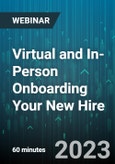We're on a new world now creating new challenges in the way we do our work including how we welcome and engage our new hires virtually.
We have new challenges now with the pandemic - how do we onboard a new employee virtually? Onboarding virtually creates new opportunities that we may continue to use even when the pandemic is not as much of a threat. Whether you call it Onboarding, Induction, Enculturation, or New Employee Orientation (NEO), the process used to welcome and train your new employees while capturing their excitement of a new job and reducing their new job jitters is critical to their success. Conducting the process virtually just adds a bit more innovation in providing the same information.
NEO is not a one day event, but rather a process that begins after their acceptance of the job and extends through the first year of their employment. Studies show that the new arrival's primary concerns are three things my job, my boss, and my coworkers.
Dealing with new employee jitters and uncertainties is a high priority in orientation programs. How long this mental mayhem lasts may depend a great deal on employee orientation. Onboarding is a strategy and a process that extends well beyond their first day on the job. It is a critical process to get the new hire off and running in their new environment - their new virtual environment, their new virtual position, and with new virtual colleagues enabling them to enjoy their work and their employer.
Onboarding needs to include fun activities, using “buddies” to streamline the new hire's experience, beginning from the point of the job offer. All of these efforts can be done virtually. It is one of the most important elements an employer should invest in.
We have new challenges now with the pandemic - how do we onboard a new employee virtually? Onboarding virtually creates new opportunities that we may continue to use even when the pandemic is not as much of a threat. Whether you call it Onboarding, Induction, Enculturation, or New Employee Orientation (NEO), the process used to welcome and train your new employees while capturing their excitement of a new job and reducing their new job jitters is critical to their success. Conducting the process virtually just adds a bit more innovation in providing the same information.
NEO is not a one day event, but rather a process that begins after their acceptance of the job and extends through the first year of their employment. Studies show that the new arrival's primary concerns are three things my job, my boss, and my coworkers.
Dealing with new employee jitters and uncertainties is a high priority in orientation programs. How long this mental mayhem lasts may depend a great deal on employee orientation. Onboarding is a strategy and a process that extends well beyond their first day on the job. It is a critical process to get the new hire off and running in their new environment - their new virtual environment, their new virtual position, and with new virtual colleagues enabling them to enjoy their work and their employer.
Onboarding needs to include fun activities, using “buddies” to streamline the new hire's experience, beginning from the point of the job offer. All of these efforts can be done virtually. It is one of the most important elements an employer should invest in.
Areas Covered in the Session:
- Sample checklists for the manager/supervisor, HR, and the Buddy are provided
- Tips on orienting the virtual employee
- How to evaluate your Onboarding process
- To discuss importance of Checklists for what to accomplish the first day, first week, first month, and the first 90 days
- To list suggested lists and topics for the onboarding portal
- To examine onboarding portal systems
- To Tips on how to select and utilize a Buddy
- Orientation Evaluation forms for the new hire, HR, the buddy, and management
- Tips on the manager-new hire “expectations” discussion
Learning Objectives:
- To describe onboarding tactics for virtual new hires
- To discuss the intricacies of onboarding the new hire including such things as getting them their new computer, technology, and having a virtual lunch, and dealing with I-9s
- To identify HR, the supervisor, and the Buddy's roles in welcoming and training the new employee to a virtual environment
- To discuss the new employee's role in her or his orientation
- To differentiate between the orientation to the organization and the orientation to the department
- To assess, develop, implement and evaluate your Onboarding strategy
- To examine virtual Onboarding best practices
- To assess, design, and develop, implement, and evaluate your department's NEO strategy








